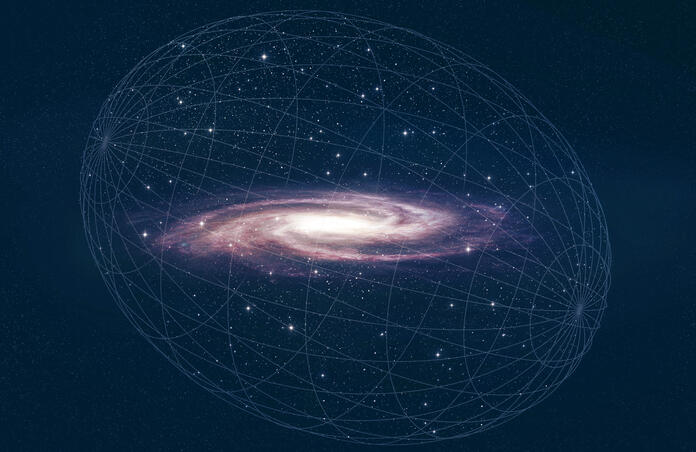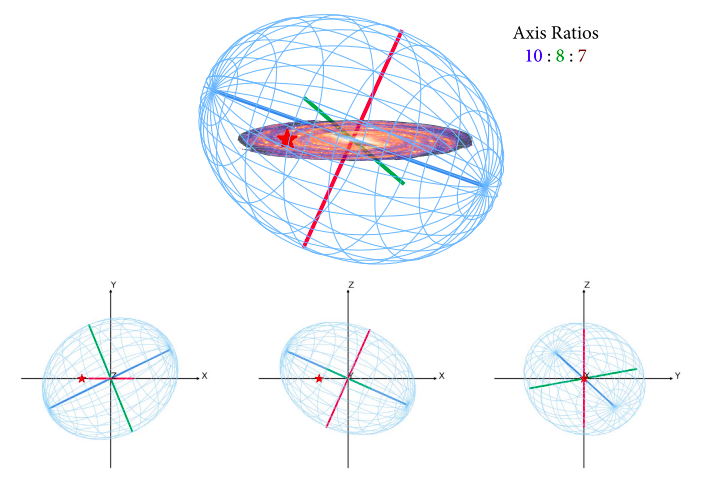The true shape of the milky way’s stellar halo revealed

For decades, astronomers have thought that the diffuse cloud of gas, stars, and dark matter known as the stellar halo is largely spherical and isotropic. However, new findings from modern observations have uncovered that the halo is actually oblong and tilted like a rugby ball. The elongated shape is mathematically dubbed as a triaxial ellipsoid whose axes have different lengths. This discovery provides insight into a number of areas in astrophysics, broadening our understanding of the history of our galaxy and its evolution in addition to revealing clues about the mystery of dark matter.
The milky way’s stellar halo comprises the visible part of a broader galactic halo, which is dominated by dark matter, a mysterious constituent whose presence is only known and measured through the gravity it exerts on other objects. Dark matter halos can be found in every galaxy, serving as a base structure on which ordinary matter sits, which makes up stars and other observable galactic structures. Because of this, stellar halos are important targets and can be utilised as tracers for dark matter. However, a problem has arisen for astrophysicists when trying to determine the shape of our stellar halo. The halo extends several hundred thousand light years above and below our solar system, and since we are situated inside this, we don’t have an outside perspective. Additionally, the halo only contains around 1% of the mass of all stars in the Milky Way, proving to be very diffuse. Despite this, astronomers have been able to identify several thousands of halo stars due to their unique chemical composition along with their distances and motions across the sky.
The new study by Centre of Astrophysics researchers analysed datasets from two surveys measured in recent years to explore the stellar halo in more detail than ever before. The first dataset used is Gaia, a spacecraft that shares Earth’s orbit around the sun. Gaia can measure the parallax of objects in the Milky Way, thus it collects precise measurements of the motions, positions, and distances of stars in our galaxy which includes some nearby halo stars. H3 (Hectochelle in the Halo at High Resolution), a ground-based survey conducted with the MMT situated in Arizona was used as the second set. The survey provides detailed observations of thousands of stellar halo stars which are too far away for Gaia to measure. After combining these observations in a model, a non-spherical stellar halo shape was uncovered which tilts 25 degrees with respect to the galactic plane.

This discovery is in strong agreement with the leading theory for the formation of this halo. Astronomers have found that around 7-10 billion years ago, a dwarf galaxy known as Gaia-Sausage-Enceladus (GSE) collided with the milky way. The funny name for the galaxy comes from the spacecraft used (Gaia), the ‘sausage’ pattern which appeared when the data was plotted and ‘Enceladus’ from the Greek mythological giant who was buried under a mountain, much like how the dwarf galaxy was buried in the Milky Way after the galactic incident. As a consequence, GSE was ripped apart and its stars were thrown out into a halo, which explains the difference in the makeup of halo stars with those born in the Milky Way. The triaxial ellipsoidal shape of the halo arises from the observations of two pileups of stars which represent the slowest and furthest points of GSE in its orbit around our galaxy.
Since the model measured the halo to have a tilt, this indicates that GSE approached the milky way at an angle rather than straight on. This event occurred long enough ago such that the tilt would’ve been corrected by now, and halo stars would’ve settled into the long-assumed spherical shape. However, this isn’t the case, which raises questions about the galactic halo. It is suggested by the team of researchers that the galactic halo is askew and its own gravity is keeping the elongated shape. The study’s co-author Charlie Conroy, a professor of astronomy at Harvard University and the Centre for Astrophysics explains, “The tilted stellar halo strongly suggests that the underlying dark matter halo is also tilted… A tilt in the dark matter halo could have significant ramifications for our ability to detect dark matter particles in laboratories on Earth."
Therefore, along with this exciting discovery comes a number of questions that can hopefully be answered by ongoing and future surveys.
--
Cover image: Melissa Weiss / Harvard & Smithsonian’s Center for Astrophysics.
Journal source: Han J.J. et al. 2022. The Stellar Halo of the Galaxy is Tilted and Doubly Broken. AJ 164, 249; doi: 10.3847/1538-3881/ac97e9
